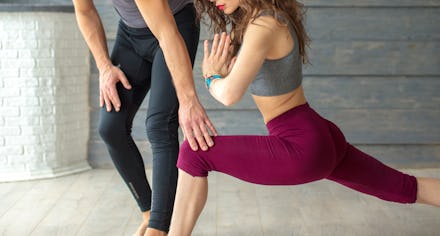Consent is the most important part of a yoga adjustment

Touch, in yoga classes, can be tricky. The term “adjustment” is often used as a catchall term for many different kinds of touching, and this ambiguity allows for some pretty egregious boundary crossing. The New York Times dropped an article a few days ago about how widespread it is for studios and yoga teachers to misuse the term “yoga adjustment” in order to alibi inappropriate touch.
I’ve been teaching yoga for 13 years — classically trained in several styles — and in that course of time I have learned a lot of conflicting things about adjustments. I’ve been taught that you should never touch a student; I have also been taught that pushing a student’s boundaries is a teacher’s job. The truth is that there has never been uniform consensus in contemporary yoga about what adjustments are and how they should best be used, and historically speaking, we just don’t know much about how ancient yogis taught or when the practice of adjusting students began.
You can imagine how this lack of agreement might be confusing. It could lead to students not knowing what “good touch” and “bad touch” is — which is at best, problematic and at worst, traumatizing. In most cases, I don’t think yoga teachers are trying to be creeps. Bu those who are creeps exploit adjustments — integral mechanisms to enhance our practice and experience — in the worst possible way.
Students often don’t know what adjustments are or what they should feel like, so they don’t always know the difference between the kind of discomfort that is built in to the practice and the kind of discomfort that screams stranger danger. Frankly, I don’t think that the onus should be on students, but the truth is the yoga market is flooded with inexperienced teachers, so let’s break it all down.
What’s the point of a yoga adjustment?
I was taught that the main point of a yoga adjustment is to help a student physically understand the shape of a pose. The body’s nervous system uses proprioception to know where it is in space. Proprioception is sometimes called the sixth sense because the concept is part sensation and part movement. When a student is learning yoga, their nervous system is learning how to "propriocept" new shapes and positions, and they often need the guidance of a teacher. So essentially, the teacher helps the student get into a pose so that the student can eventually develop the skills to feel the pose’s maximum benefits.
An adjustment can have several more subtle intentions; it can be used to help a student understand the basic form (shape) of a pose, develop proper alignment (arrangement of joints and bones) or correct misalignment, or move into a deeper variation of a pose. Adjustments can also be used for pleasure, like massage.
What should an adjustment feel like?
Not all adjustments are manual — some don’t use touch at all. These are verbal cues such as, “press down through the ball of your right big toe.” Manual adjustments can be anything from simply pressing down the edge of your foot in triangle pose to adjusting your ribcage in a deep twist. A physical adjustment should feel stabilizing, meaning that a teacher should be touching only the bigger, more stable bones of the body or offering you a prop or a part of their own body to resist into.
It should go without saying that a teacher should not touch you with their genitals, but several women cited in the Times experienced just that, so apparently, that needs to be said. I don’t know which yoga teachers need to hear this but: No one should touch you with their genitals nor should they touch your genitals.
Also, a teacher should say at the beginning of class whether they plan to offer adjustments or not. Some teachers will use the word “assists” — they mean the same thing. Teachers should offer an easy way to opt out or in. A lot of studios use consent cards that you flip depending on whether you want to be touched or not.
A teacher should ask for consent again before each adjustment. They should specify the reason for the assist, where they are planning to touch, and ask for consent again. I am not a fan of consent cards because they put the responsibility on the student to determine whether or not they want to be touched without giving them more information, but they can be necessary timesavers in large classes.
Because touch is so crucial to yoga, this is what should happen in order to create an ideal environment for your practice. But the truth is that most teachers, including me, don’t ask for consent every single time they touch you. If a teacher’s touch makes you feel physically less stable, is painful, or feels boundary-crossing in any way, say, “No.” Out loud. You can explain later if you feel like it, but it’s not on you. An assist in yoga should feel like a little epiphany, either because you learned something new or because you feel safe and seen. If it doesn’t, it’s a no.